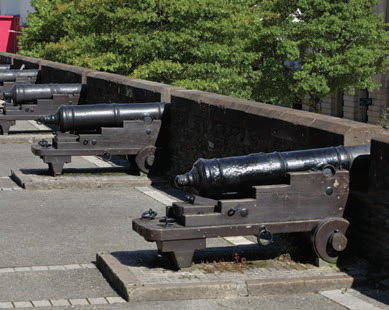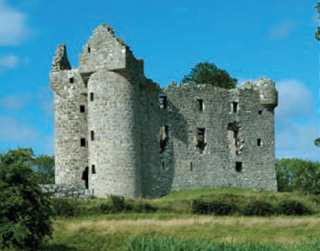Today
Although the Plantation of Ulster began over 400 years ago, there are still some reminders of it that survive today. Some of these you will be able to visit, but others will be hidden away and not easy to get to.
Derry’s Walls
In 1613 the town of Derry was renamed Londonderry because the London companies now became responsible for it.
In the same year the building of new walls around the town began.
The walls were completed in 1618.
Today the walls survive almost intact and it is possible to walk along their full length of just over one mile. The walls are the most important surviving 17th century fortifications in the British Isles and well worth a visit. The remains of other town walls built at this time can be seen at Carrickfergus, County Antrim, and Jamestown, County Leitrim.

Cannon on the walls of Derry
Plantation castles
Those granted land were required to build a fortification on their lands. The simplest type of fortress was known as a ‘bawn’. The word bawn comes from the Irish for ‘cow fort’.
A bawn was a courtyard surrounded by strong walls and was usually square or rectangular. The most important of the new English and Scottish landlords were expected to build a strong castle as well as a bawn.
The ruins of some of the castles built by the undertakers and servitors in the Plantation counties have survived. In County Fermanagh it is possible to visit Monea Castle, probably the finest surviving Plantation castle. It was built by Malcolm Hamilton, one of the Scottish undertakers. Comparisons have been made with Claypotts Castle near Dundee.

Monea Castle
Plantation churches
The English and Scottish settlers needed places to gather for public worship.
Sometimes they repaired an existing church and on other occasions they built a completely new church. A handful of these churches are still in use. The largest church built in the Plantation counties is St Columb’s Cathedral in Londonderry. It is still used every day and is very popular with tourists.
Other churches include Clonfeacle Church of Ireland church in Benburb, County Tyrone. This church was built around 1620 by Sir Richard Wingfield, an English servitor.
Most of the churches that survive from the Plantation counties are in ruins. In the old graveyards surrounding these churches it is sometimes possible to find a tombstone to one of the original settlers.

Saint Columb’s Cathedral, Londonderry
